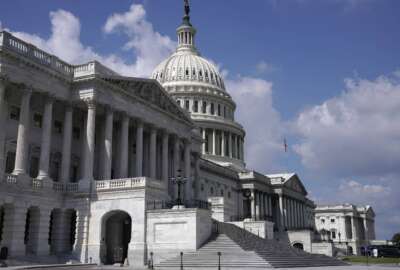
One group of administrative judges needs more independence from its agency
To keep patent disputes out of the courts, Congress formed the Patent Trial and Appeal Board a few years back in the America Invents Act. A survey of patent jud...
To keep patent disputes out of the courts, Congress formed the Patent Trial and Appeal Board a few years back in the America Invents Act. A survey of patent judges conducted by the Government Accountability Office came up with a disturbing finding. Three quarters of the judges said U.S. Patent and Trademark Office management pressured them to change their decisions. To get more on this story, the Federal Drive with Tom Temin spoke with Candice Wright, GAO’s director for science, technology assessment and analytics.
Interview transcript:
Candice Wright
So the issue that, we focused on in our work and we were asked to look at this issue, because there were concerns by various entities, including Congress about whether certain oversight practices that were being used by the Patent Trial & Appeal Board management or the United States Patent and Trademark Office director could be influencing judges’ decisions. There had been challenges in the past about whether judges could operate and make decisions independent of the USPTO director. And in fact, there was a case that went to the Supreme Court. And in 2021, the Supreme Court decided that the director should have the ability to review judges’ final decisions in certain circumstances. So what we were asked to do was to look at the practices that are in place have been used by PTAB management and USPTO, director to oversee judicial decision making.To do that work, we conducted a survey to gain insight on the judges’ perspectives on these practices, including the extent to which these practices were affecting their deliberations and decisions. What we did hear from judges is that for 75%, of those who responded, which we had a pretty high response rate, but 75% of those who responded didn’t know that there were concerns that these oversight practices affected or stepped on their independence. Now I will say to be fair, some of the judges said that management did not get involved in most cases. But where it did occur, sometimes they felt pressure to change or modify an aspect of their decision. I think it’s really important to make clear, though, that while they may have felt that pressure, we didn’t hear definitively whether people actually acted on that and made those changes or altered their decisions. But certainly just the notion that there was this pressure in place. And oftentimes this occurred with decisions such as whether or not to grant a trial for something to come before the board, and not so much on the merits of the patentability itself.
Tom Temin
And just for informational purposes, then that means that a judge can render a decision on appeal from the patent examiner, and then that judge’s decision can go to a trial by multiple judges?Candice Wright
So it’s usually a panel of judges, oftentimes a three-panel-judge, and so they will get these petitions for something to be heard before the board and will first make a decision whether or not it meets the requirements and the eligibility to come before the board. And that’s something that’s called institution. And then if they determine that the petition meets those requirements, it might be, for example, things that they have to consider like whether or not there’s a parallel case in district court, for example. So they will have a set of criteria that they’ll look at to make that determination. And then if a determination is made, that it meets the criteria, then they will institute a trial, and that panel of judges will review the case and make a decision.Tom Temin
And just for purposes of context, would it be accurate to say that the U.S. Patent and Trademark Office director and by presumption the staff, the senior staff can also review cases that are decided by the patent examiners in the first place.Candice Wright
So in this instance, what we’re talking about are examples where a patent has been issued, and a patent owner is alleging that there’s infringement on the patent. And so the accused infringer may seek to get a hearing to dispute the merits of the patent being issued in the first place, there might be concerned that the patent is overly broad. And so they’ll see to try to have the PTAB take a look at the patent that was issued. And whether or not there is I guess, validity to the infringement.Tom Temin
So this is not cases then of people applying for a patent getting turned down and then going to the PTAB to try to get that changed.Candice Wright
So they also do hear those cases as well, where somebody may have applied for a patent and the patent was not granted and then they’re looking to appeal that.Tom Temin
We’re speaking with Candace Wright, director for Science Technology Assessment and Analytics at the Government Accountability Office. All right, so you have the situation where the judges say they feel this pressure. There’s not a lot of hard evidence that the pressure has caused changes in renderings of the judges. What then were the recommendations, how can they get out of the situation so that the judges feel independent, actually, are independent. And yet there is oversight?Candice Wright
It’s interesting. The things that we heard in the course of our work were that there were two oversight practices that were of concern or number of oversight practices that had been implemented. As the PTAB was established and grew. These particular practices that were concerned were instances where there were peer reviews of draft decisions. And this would happen before issuance of the final decision, as well as management review of draft decisions. Those are probably two of the things that we heard that were among the most concerning practices. During the course of our review, in fact, the PTAB had been hearing concerns about this and had been considering different approaches. And so actually, during the course of our review, implemented some new procedures to try and improve the transparency about the oversight practices. A couple of things that I’ll note is the peer review oversight practice that I mentioned, that has actually now been replaced by a new interim review, wherein the USPTO director of PTAB management would not be involved in any of those reviews of draft decisions. The management review, as again, another one that was concerning to judges is no longer required, and is now to only take place at the judge panels’ requests. And so those are some some of the new changes. Again, these are all still things that while they have been announced, they are still considered interim processes. And so we thought that it was really important that as the agency moves forward, that they really take a look at implementing things that will help increase transparency and formalize these practices. And so to that end, we made four recommendations.We think that this is something that, certainly we saw that it was a focus for the current director and wanted to make sure that, they followed through and finalizing these. So couple of things that we recommended is that as the agency finalizes its policies for internal reviews, like the management reviews, for example, that they’re very clear and clarify the role of the PTAB management and the USPTO director, including information about who is actually going to be reviewing the draft decisions, because that was something that had been a concern, as judges felt like they sent in their draft decisions for review. It went into a black hole, and they were never certain about who was reviewing it, who was providing the comments. And so we think that it’s really important to articulate that and clarify that in the new guidance as it gets finalized. And then also, too, when comments are provided the extent to which they are optional, or they are mandatory and must be integrated. Again, that was something that wasn’t clear until we thought that was important. There also seemed to be just some communication challenges between the judges and the leadership. And so we thought it was really important that as they move forward, that they improve internal communications with the judges to promote transparency and openness. Again, this means being clear with the judges about USPTO policies, the expectations, what’s required, and also making sure that as these things are communicated that they’re not just communicated verbally, but that they’re also communicated in writing.
Tom Temin
So then there is some work to do both by USPTO management itself as well as the PTAB management?Candice Wright
Correct.Tom Temin
Interesting. And both groups said, yeah we agree with your recommendations?Candice Wright
They agree with our recommendations. And again, certainly noted that they already had actions underway or plans to take actions. We’ll continue to follow this, as we always do with our recommendations to see where the agency is implementing our recommendations. But again, we think that these are good steps in the right direction. I think the really key thing here is as you think about sort of implementing these kinds of changes, is how do you sort of move through from being aspirational to intentional to actionable, so the aspiration is that you’re going to have these policies in place. But then the intentional is that the leadership is actually demonstrating that they’re taking this seriously and following through, it’s sort of the whole show me don’t tell me. And then lastly, making sure that folks are being held accountable by not just saying what you’re going to do, but putting that in writing, and being transparent about it and making it publicly available as well, because people who come before the PTAB, want to make sure that they have a full understanding of how decisions are being made. And so that’s another piece that we had heard during the course of the work and we think is an important element to address.
Copyright © 2024 Federal News Network. All rights reserved. This website is not intended for users located within the European Economic Area.
Tom Temin is host of the Federal Drive and has been providing insight on federal technology and management issues for more than 30 years.
Follow @tteminWFED
Related Stories





